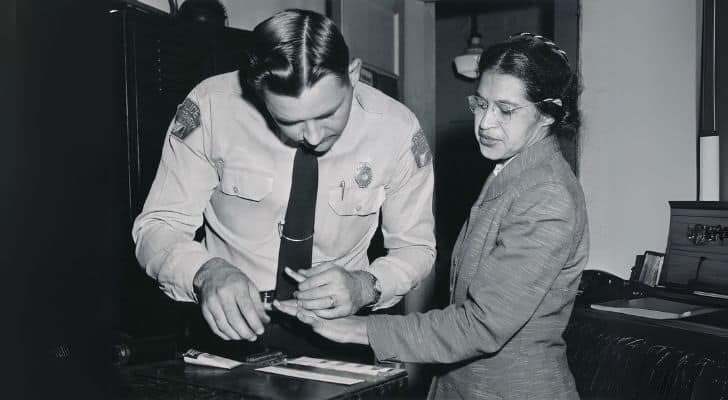Rosa Parks is celebrated as the mother of the civil rights movement. She has received countless honors, even after her passing, for her immense contributions to fighting injustices.
It all began with her courage to say no, to refuse to give up her seat on a bus in Montgomery, Alabama.
But beyond what you’ve learned in the classroom, how well do you know this woman who changed the course of history?
Uncover the life behind the iconic bus moment and let Rosa Park’s incredible courage inspire you!
Rosa Louise McCauley was born to Leona and James McCauley on February 4, 1913, in Tuskegee, Alabama. Her mom was a teacher, and her dad was a carpenter.
She’s primarily of African American descent but also has Scots-Irish and Native American ancestry.
When she was just two years old, her parents separated. Her mom, who was pregnant then, moved them to Pine Level, Alabama, to live with Parks’ grandparents.
In 1915, not long after her parents separated, Parks became a big sister when her brother Sylvester was born.
Parks’ mom was a fantastic teacher who taught her to read long before she stepped foot into a classroom.
Another skill Parks picked from her mom was sewing; she got very good at it quickly. By the time she was ten, she made her first quilt from scratch.
At 11, she started attending the Montgomery Industrial School for Girls. Here, she got better at sewing and could soon make dresses for herself.
Parks wanted to be a teacher just like her mother, so she enrolled at the Alabama State Teachers College for Negroes. Unfortunately, she had to drop out of school in 11th grade to take care of her ill grandmother.
In 1932, at 19, she married Raymond Parks. He was a barber and also an active member of The National Association for the Advancement of Colored People (NAACP).
After marriage, her husband encouraged her to return to school to get her high school diploma, which she did in 1933. Thus, she became one of the 7% of African Americans who graduated high school successfully at the time.
Parks was a hard worker, taking on many jobs throughout her life. She worked as a domestic worker, seamstress, and hospital aide.
In 1943, Parks joined the NAACP and was elected chapter secretary at her first meeting. This kicked off her lifelong journey into activism, during which she championed civil rights and social justice causes.
On December 1, 1955, a mere 69 years ago, Parks was arrested for refusing to give up her bus seat for a white man.
About 12 years before the famous bus ride, Parks had an unpleasant encounter with the bus driver, James Blake. When she entered the bus through the front door, he kicked her off and sped off before she could use the rear door.
Rosa Parks wasn’t the first woman to be arrested for refusing to back down from her seat on the bus, though. Nine months prior, 15-year-old Claudette Colvin was arrested on her way home from school for refusing to give up her bus seat for a white passenger.
Parks’ protest on the bus wasn’t planned or staged. She was just tired, not physically but mentally exhausted from the systemic oppression African Americans faced every waking minute of their lives.
After a quick trial, Parks was given a suspended sentence and ordered to pay a $10 fine in addition to $4 for court costs. This is equivalent to about $161.11 in 2024.
Park’s arrest sparked the Montgomery bus boycott. For 381 days, African Americans stopped taking the city buses, causing a major blow to the bus company’s finances.
Following the bus boycott, the Parks family’s situation went downhill. Rosa Parks lost her job, and so did her husband, forcing them to move out of Montgomery.
When she moved to Detroit, Parks saw many of the same systemic issues. She joined protests for fair housing, backed Congressman John Conyers, and even spoke to Martin Luther King Jr, to endorse his campaign.
After Conyers was elected, he recognized her dedication and hired Parks as his office secretary and receptionist. She worked with him tirelessly until her retirement in 1988.
1977 was a challenging year for Parks, as she lost both her husband and her brother to cancer just three months apart.
In 1987, Rosa Parks and her longtime friend, Ms. Elaine Eason Steele, formed The Rosa and Raymond Parks Institute for Self-Development in honor of Raymond Parks. The organization was formed to honor their lives and get more people involved in social justice.
In 1992, she published her autobiography, Rosa Parks: My Story. Then, in 1995, she shared another side of herself with a memoir on her faith titled Quiet Strength.
Rosa received two of the nation’s highest awards in honor of her lifelong service to the fight for justice: the Presidential Medal of Freedom from President Bill Clinton in 1996 and the Congressional Gold Medal from the US Congress in 1999.
Parks passed away in her Detroit apartment on October 24, 2005, at the age of 92.
After her passing, her body was brought to Washington, D.C., to lie in honor in the US Capitol rotunda. She was the first woman and second African American to receive this honor.
Although Parks never attended college, she received over 40 honorary doctorate degrees from different institutions throughout her life. Some of these include Florida State University in Tallahassee, Florida, and Soka University in Tokyo, Japan,
In 2003, the bus Parks was riding was restored and displayed in The Henry Ford Museum.
In 2019, Mattel released a Rosa Parks doll as part of the Barbie Inspiring Women series. The Rosa Parks doll is dressed in the same outfit as that fateful day on the bus: a floral dress and wool coat.

What an incredibly inspiring story! If there’s one thing you must take from it, it’s that anyone has the power to do great things, no matter how put down upon they are.
Rosa Parks’s life teaches us that you don’t always need to perform grand gestures to bring about change.
Sometimes, all it takes is standing firm and staying true to what you believe is right, and a revolution is born.


















